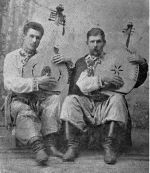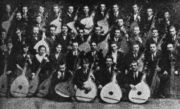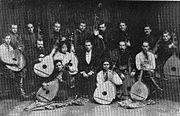
Vasyl Yemetz
Encyclopedia
Vasyl' Kostovych Yemetz (2 August 1890-4 January 1982) (also went by Wassyl, Vassyl) was born in the village of Sharivka, 40 km from Kharkiv
, Ukraine
. Son of Kost' and Yevdokia (Kurakhovych). Married to Maria Horta-Doroshenko. Virtuoso bandurist
, founder and initial director of the Kobzar Choir in 1918 - the direct protege of the Kiev Bandurist Capella
.
 Yemetz was born to a Cossack family. His father was interested in Ukrainian ethnography and his family was one of the first to have a phonograph (1899) with which they recorded and collected folk songs. It is from one of the local kobzari, Ivan Kucherenko
Yemetz was born to a Cossack family. His father was interested in Ukrainian ethnography and his family was one of the first to have a phonograph (1899) with which they recorded and collected folk songs. It is from one of the local kobzari, Ivan Kucherenko
, that Yemetz became drawn to the culture of the kobzari and learned to play the bandura
in 1908.
His first performance as a bandurist
took place in 1911, and became very controversial because of the text of the song he chose to sing.
He studied at the Kharkiv
University (1911–13) but was forced to transfer in 1914 to Moscow University because of his political activities. In Moscow he became the first bandurist to perform solo in the Bolshoi Theatre
in 1916. After this performance he was first hailed as a virtuoso in the Russian press.
In the summer of 1913 he was invited by Mykola Bohuslavsky
to Yekaterinodar in the Kuban
to teach bandura. He was instrumental is establishing the modern bandura playing tradition amongst the Kuban Cossacks
.
After completing his studies at the Moscow University he received a teaching position in 1917 in Sosnytsia
, Chernihiv
province in Ukraine. There he was chosen as a delegate at the All-Ukr. National Congress held in Kiev in 1917.
In 1918 he moved to Kiev
where he organized the first professional Bandurist Capella known as the Kobzar Choir. The first concert of the group taking place in the Bergone Theatre in Kyiv on November 3, 1918. The ensembles last concert was a Taras Shevchenko
concert in March 1919.
In 1918-20 he served with the Ukrainian National Army.


 In 1921 he moved to Berlin where he continued his studies at the Berlin Conservatory
In 1921 he moved to Berlin where he continued his studies at the Berlin Conservatory
. In Berlin he published a number of articles about the kobzari, which included materials about his interactions with them. This led to the publication of his first book on the Kobzari.
In 1923 he moved to Prague
, which had become a major Ukrainian emigre centre. Here he set up a school for the teaching of the bandura in Prague and Podebrady
in 1923 which had over 60 students. A workshop for the manufacturing of instruments was established which made over 100 instruments. In 1926 the first collection of works for the bandura was published in Prague.
On the basis of the many bandura students Yemetz established a second Bandurist Capella
in Prague and also a number of smaller bandura ensembles in the Ukrainian Gymnasium, the Ukrainian Free University
, the Drahomanov Pedagogical Institute in Prague and the Forestry Institute in Podebrady.
Yemetz's highly publicized activities stimulated the re-establishment of the Kiev
Bandurist Capella, the formation of the Poltava Bandurist Capella
and the establishment of formal bandura classes in Kharkiv in 1926. The students of the Czech bandura schools established a culture of bandura playing in Western Ukraine and Poland when many students returned there after completing their studies.
Yemetz's brother-in-law Hryhory Kopan wrote to him inviting him back to Kiev
to re-establish the KievBandurist Capella in the early 1920s, however he declined to return.
In 1926 Yemetz continued touring Eastern Europe with solo recitals. In 1927, he first performed in France
and Belgium
. In early 1929 he tour Transcarpathian Ukraine and Romania, before returning to France and setting off for North America.
 In 1929 Yemetz toured North America for the first time to great success recording his first record there in 1932.
In 1929 Yemetz toured North America for the first time to great success recording his first record there in 1932.
In 1934 Yemetz returned to France. He returned to North America in 1937 touring all the major cities of Canada and the United States. He married and in 1941 became an American citizen.
Yemetz settles in Hollywood and starts work in 1945 on constructing a chromatic concert bandura. He develops a new repertoire for the instrument and tours the United States in 1946 with classical transcriptions played on the new chromatic concert bandura This is the first time that such works as Beethoven's "Moonlight sonata" and Tchaikovsky's "Arabian dance" were performed on the bandura.
In 1952, he records an LP record, however it was not commercially released.
After 1956, he retired from performing and spent most of his time collecting materials and writing memoirs many of which remain unpublished. Much of his archives including music, photographs and concert programs were stored in a trunk he had left with a musicologist in Winnipeg and were destroyed during the Great Flood.
He died in Hollywood January 4, 1982.
Kharkiv
Kharkiv or Kharkov is the second-largest city in Ukraine.The city was founded in 1654 and was a major centre of Ukrainian culture in the Russian Empire. Kharkiv became the first city in Ukraine where the Ukrainian Soviet Socialist Republic was proclaimed in December 1917 and Soviet government was...
, Ukraine
Ukraine
Ukraine is a country in Eastern Europe. It has an area of 603,628 km², making it the second largest contiguous country on the European continent, after Russia...
. Son of Kost' and Yevdokia (Kurakhovych). Married to Maria Horta-Doroshenko. Virtuoso bandurist
Bandurist
A bandurist is a person who plays the Ukrainian plucked string instrument known as the bandura.-Types of performers:There are a number of different types of bandurist who differ in their paricular choice of instrument, the specific repertoire they play and manner in which they approach their...
, founder and initial director of the Kobzar Choir in 1918 - the direct protege of the Kiev Bandurist Capella
Kiev Bandurist Capella
The Kiev Bandurist Capella is a male vocal-instrumental ensemble that accompanies its singing with the playing of the multi-stringed Ukrainian folk instrument known as the bandura....
.
Biography

Ivan Kuchuhura Kucherenko
Ivan Iovych Kuchuhura-Kucherenko Ivan Iovych Kuchuhura-Kucherenko Ivan Iovych Kuchuhura-Kucherenko (July 7, 1878—November 24, 1937 was a Ukrainian minstrel (kobzar) and one of the most influential kobzars of the early 20th century...
, that Yemetz became drawn to the culture of the kobzari and learned to play the bandura
Bandura
Bandura refers to a Ukrainian plucked string folk instrument. It combines elements of a box zither and lute, as well as its lute-like predecessor, the kobza...
in 1908.
His first performance as a bandurist
Bandurist
A bandurist is a person who plays the Ukrainian plucked string instrument known as the bandura.-Types of performers:There are a number of different types of bandurist who differ in their paricular choice of instrument, the specific repertoire they play and manner in which they approach their...
took place in 1911, and became very controversial because of the text of the song he chose to sing.
He studied at the Kharkiv
Kharkiv
Kharkiv or Kharkov is the second-largest city in Ukraine.The city was founded in 1654 and was a major centre of Ukrainian culture in the Russian Empire. Kharkiv became the first city in Ukraine where the Ukrainian Soviet Socialist Republic was proclaimed in December 1917 and Soviet government was...
University (1911–13) but was forced to transfer in 1914 to Moscow University because of his political activities. In Moscow he became the first bandurist to perform solo in the Bolshoi Theatre
Bolshoi Theatre
The Bolshoi Theatre is a historic theatre in Moscow, Russia, designed by architect Joseph Bové, which holds performances of ballet and opera. The Bolshoi Ballet and Bolshoi Opera are amongst the oldest and most renowned ballet and opera companies in the world...
in 1916. After this performance he was first hailed as a virtuoso in the Russian press.
In the summer of 1913 he was invited by Mykola Bohuslavsky
Nikolay Boguslavsky
Boguslavsky Mykola Oleksiyevych Was an organiser and sponsor of the kobzar renaissance in the Kuban, a community leader, publisher. Bohuslavsky organized the first and second schools of kobzar art in the Kuban...
to Yekaterinodar in the Kuban
Kuban
Kuban is a geographic region of Southern Russia surrounding the Kuban River, on the Black Sea between the Don Steppe, Volga Delta and the Caucasus...
to teach bandura. He was instrumental is establishing the modern bandura playing tradition amongst the Kuban Cossacks
Kuban Cossacks
Kuban Cossacks or Kubanians are Cossacks who live in the Kuban region of Russia. Most of the Kuban Cossacks are of descendants of two major groups who were re-settled in the Western Northern Caucasus during the Caucasus War in the late 18th century...
.
After completing his studies at the Moscow University he received a teaching position in 1917 in Sosnytsia
Sosnytsia
Sosnytsia is a townlet and administrative center of the Sosnytsky Raion of the Chernihiv Oblast in north-central Ukraine. The townlet is located on the west bank of the Ubid' river, a tributary of the Desna river, some from Chernihiv, the province center.Sosnytsia was the birthplace of...
, Chernihiv
Chernihiv
Chernihiv or Chernigov is a historic city in northern Ukraine. It is the administrative center of the Chernihiv Oblast , as well as of the surrounding Chernihivskyi Raion within the oblast...
province in Ukraine. There he was chosen as a delegate at the All-Ukr. National Congress held in Kiev in 1917.
In 1918 he moved to Kiev
Kiev
Kiev or Kyiv is the capital and the largest city of Ukraine, located in the north central part of the country on the Dnieper River. The population as of the 2001 census was 2,611,300. However, higher numbers have been cited in the press....
where he organized the first professional Bandurist Capella known as the Kobzar Choir. The first concert of the group taking place in the Bergone Theatre in Kyiv on November 3, 1918. The ensembles last concert was a Taras Shevchenko
Taras Shevchenko
Taras Hryhorovych Shevchenko -Life:Born into a serf family of Hryhoriy Ivanovych Shevchenko and Kateryna Yakymivna Shevchenko in the village of Moryntsi, of Kiev Governorate of the Russian Empire Shevchenko was orphaned at the age of eleven...
concert in March 1919.
In 1918-20 he served with the Ukrainian National Army.
Emigration in Europe



Berlin Conservatory
Berlin Conservatory may refer to:*Berlin University of the Arts, founded in 1975 with the merger of the Berlin State School of Fine Arts and the Berlin State School of Music. Its history dates back to the Akademie der Künste in 1696...
. In Berlin he published a number of articles about the kobzari, which included materials about his interactions with them. This led to the publication of his first book on the Kobzari.
In 1923 he moved to Prague
Prague
Prague is the capital and largest city of the Czech Republic. Situated in the north-west of the country on the Vltava river, the city is home to about 1.3 million people, while its metropolitan area is estimated to have a population of over 2.3 million...
, which had become a major Ukrainian emigre centre. Here he set up a school for the teaching of the bandura in Prague and Podebrady
Podebrady
Poděbrady is a historical spa town in the Central Bohemian Region, Czech Republic. It lies on the river Labe 50 km east of Prague on the D11 highway. A historic milestone in the life of the town was the year 1905, when it was visited by the German estate owner Prince von Bülow...
in 1923 which had over 60 students. A workshop for the manufacturing of instruments was established which made over 100 instruments. In 1926 the first collection of works for the bandura was published in Prague.
On the basis of the many bandura students Yemetz established a second Bandurist Capella
Prague Bandurist Capella
The Prague Bandurist Capella was a musical ensemble formed in 1924 by Ukrainians living in Czechoslovakia featuring performers on the bandura....
in Prague and also a number of smaller bandura ensembles in the Ukrainian Gymnasium, the Ukrainian Free University
Ukrainian Free University
The Ukrainian Free University is a private graduate university located in Munich, Germany.-History:The Ukrainian Free University was established in Vienna, January 17, 1921. The idea to organize a Ukrainian university-in-exile came from Ukrainian academics, some of whom had held chairs at...
, the Drahomanov Pedagogical Institute in Prague and the Forestry Institute in Podebrady.
Yemetz's highly publicized activities stimulated the re-establishment of the Kiev
Kiev
Kiev or Kyiv is the capital and the largest city of Ukraine, located in the north central part of the country on the Dnieper River. The population as of the 2001 census was 2,611,300. However, higher numbers have been cited in the press....
Bandurist Capella, the formation of the Poltava Bandurist Capella
Poltava Bandurist Capella
The Poltava Bandurist Capella was vocal-instrumental ensemble who accompanied themselves on the multi-stringed Ukrainian bandura. It was initially established in February 1925, based on a male church choir who sang in the Ukrainian Autocephalous Orthodox Cathedral in Poltava under the direction of...
and the establishment of formal bandura classes in Kharkiv in 1926. The students of the Czech bandura schools established a culture of bandura playing in Western Ukraine and Poland when many students returned there after completing their studies.
Yemetz's brother-in-law Hryhory Kopan wrote to him inviting him back to Kiev
Kiev
Kiev or Kyiv is the capital and the largest city of Ukraine, located in the north central part of the country on the Dnieper River. The population as of the 2001 census was 2,611,300. However, higher numbers have been cited in the press....
to re-establish the KievBandurist Capella in the early 1920s, however he declined to return.
In 1926 Yemetz continued touring Eastern Europe with solo recitals. In 1927, he first performed in France
France
The French Republic , The French Republic , The French Republic , (commonly known as France , is a unitary semi-presidential republic in Western Europe with several overseas territories and islands located on other continents and in the Indian, Pacific, and Atlantic oceans. Metropolitan France...
and Belgium
Belgium
Belgium , officially the Kingdom of Belgium, is a federal state in Western Europe. It is a founding member of the European Union and hosts the EU's headquarters, and those of several other major international organisations such as NATO.Belgium is also a member of, or affiliated to, many...
. In early 1929 he tour Transcarpathian Ukraine and Romania, before returning to France and setting off for North America.
North America

In 1934 Yemetz returned to France. He returned to North America in 1937 touring all the major cities of Canada and the United States. He married and in 1941 became an American citizen.
Yemetz settles in Hollywood and starts work in 1945 on constructing a chromatic concert bandura. He develops a new repertoire for the instrument and tours the United States in 1946 with classical transcriptions played on the new chromatic concert bandura This is the first time that such works as Beethoven's "Moonlight sonata" and Tchaikovsky's "Arabian dance" were performed on the bandura.
In 1952, he records an LP record, however it was not commercially released.
After 1956, he retired from performing and spent most of his time collecting materials and writing memoirs many of which remain unpublished. Much of his archives including music, photographs and concert programs were stored in a trunk he had left with a musicologist in Winnipeg and were destroyed during the Great Flood.
He died in Hollywood January 4, 1982.
Sources
- Kudrytsky, A. V. - Mystetsvo Ukrainy - Biohrafichnyj dovidnyk - Kyiv 1997
- Ukrainians in North America, USA
- Кіндзерявий-Пастухів, С. - Думки вголос – Кобзарський листок Рік 5 ч. 39, Січень 1978, (Про записи з грою В. Ємця)
- Литвин, М. – Струни золотії – “Веселка”, К.:1994 (117с.)
- Самчук, У. - Живі струни - Детройт, США, 1976 (468с.)

